Head Coach of India Cricket Team: A Comprehensive Guide
India’s cricketing history is marked by memorable performances and world-class players, but behind every successful team stands a capable leader guiding the team to victory. The head coach of the India cricket team plays a crucial role in ensuring the team’s sustained success and growth. This article delves deep into the responsibilities, history, selection process, and influence of the head coach, along with insights into the current head coach’s tenure.
Roles and Responsibilities of the Head Coach
The head coach is tasked with leading the team in various aspects, including strategy, performance enhancement, and team dynamics. Below are the core responsibilities:
1. Strategic Planning and Game Tactics
- Formulates game strategies tailored to specific opponents.
- Collaborates with the captain to decide batting and bowling orders.
2. Player Development
- Mentors young talent and refines the skills of experienced players.
- Focuses on fitness, technique, and mental preparation.
3. Team Selection and Coordination
- Works closely with selectors to identify the best squad.
- Aligns with assistant coaches and support staff for a cohesive approach.
4. Performance Analysis
- Reviews past performances using analytics to devise improvement plans.
- Provides actionable feedback to players after matches.
5. Media and Public Engagement
- Represents the team during press conferences.
- Acts as a bridge between players and media, managing external pressures.
History of the Head Coach Role in Indian Cricket
India introduced the concept of a full-time head coach in the late 1990s. Since then, several iconic personalities have contributed significantly to the team’s growth.
| Year | Coach | Tenure Highlights | Major Achievements |
|---|---|---|---|
| 2000-2005 | John Wright | First foreign coach; nurtured young talent | NatWest Trophy 2002, 2003 WC Finalists |
| 2007-2011 | Gary Kirsten | Built a strong, united team | ICC Cricket World Cup 2011 |
| 2015-2017 | Anil Kumble | Focused on discipline and team unity | Test series wins in Australia and South Africa |
| 2017-2021 | Ravi Shastri | Elevated team performance across formats | Back-to-back Test series wins in Australia |
| 2021-Present | Rahul Dravid | Focus on youth development and team rebuilding | ICC World Test Championship qualification |
Current Head Coach of India Cricket Team
As of December 2024, Rahul Dravid serves as the head coach. Appointed in 2021, his tenure emphasizes nurturing young talent and maintaining consistency in performance. Dravid, known for his calm demeanor and meticulous planning, has been instrumental in preparing India for future challenges.
Key Achievements under Rahul Dravid:
- Consistent performance in bilateral series across formats.
- Grooming young players like Shubman Gill and Ishan Kishan.
- Qualifying for the ICC World Test Championship Final in 2023.
Selection Process of the Head Coach
The Board of Control for Cricket in India (BCCI) oversees the selection process. Here’s how it unfolds:
- Advertisement and Application:
The BCCI advertises the position and invites applications from qualified candidates. - Eligibility Criteria:
- International playing experience or equivalent coaching credentials.
- Previous coaching roles with reputed teams.
- Evaluation by Cricket Advisory Committee (CAC):
The CAC shortlists candidates based on interviews and presentations. - Final Appointment:
The selected candidate is offered a contract, typically spanning two years with an option for renewal.
Influence of the Head Coach on Indian Cricket
The head coach’s decisions profoundly impact the team’s performance. A few areas where the coach’s influence is evident include:
- Team Culture: Encourages a positive, winning mindset.
- Fitness Standards: Coaches like Anil Kumble and Ravi Shastri set high benchmarks for fitness.
- Tactical Mastery: Innovations such as promoting pinch hitters or surprise bowling changes.
Challenges Faced by the Head Coach
The head coach role comes with its fair share of challenges:
1. Balancing Senior and Junior Players
Managing the expectations of seasoned players while giving opportunities to emerging talent.
2. High Public Expectations
Cricket is a religion in India, and fans demand consistent victories.
3. Transition Phases
Navigating through player retirements and rebuilding phases, as seen post-MS Dhoni and Virat Kohli’s captaincy eras.
The Evolution of Coaching Philosophy
Indian cricket has witnessed a shift in coaching styles over the years:
| Era | Focus Areas | Coaching Style |
|---|---|---|
| Pre-2000s | Basic skills and fitness | Player-driven; minimal external input |
| 2000-2010 | Analytics and foreign expertise | Professional and structured |
| 2010-Present | Holistic development and innovation | Data-driven; emphasis on mental resilience |
Future of the Head Coach Role in Indian Cricket
With Indian cricket evolving, the future head coach is expected to:
- Embrace advanced analytics and technology for performance enhancement.
- Foster inclusivity, promoting women’s cricket alongside the men’s team.
- Focus on ICC tournament wins, an area of improvement for the team.
FAQs About the Head Coach of India Cricket Team
Q1. Who was India’s first foreign coach?
A1. John Wright from New Zealand, appointed in 2000.
Q2. How long is the tenure of the head coach?
A2. Typically two years, with an option for renewal.
Q3. What are the qualifications required to become the head coach?
A3. International playing experience or extensive coaching credentials.
Conclusion
The head coach of the India cricket team plays a pivotal role in shaping the team’s legacy. From strategic planning to inspiring players, their contribution extends beyond the cricket field. With a rich history of impactful coaches, India continues to benefit from strong leadership at the helm. The journey of Indian cricket is intertwined with the vision and dedication of its head coaches, ensuring a bright future for the sport.


